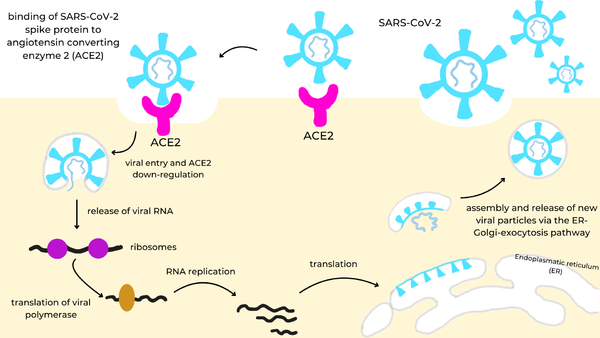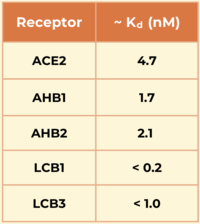User:Carson Powers/Sandbox 1
From Proteopedia
(Difference between revisions)
| Line 6: | Line 6: | ||
[[Image:spike_infection_cycle.png|600px|right|SARS-CoV-2 infection cycle: the viral spike protein (cyan) binds to the ACE2 receptor (magenta) on the cell surface, triggering endocytosis and ACE2 down-regulation, release of viral RNA into the cytosol, translation of the viral polymerase and genome replication, synthesis of structural proteins in the endoplasmic reticulum (ER), and assembly and release of new virions via the ER-Golgi-exocytosis pathway.]] | [[Image:spike_infection_cycle.png|600px|right|SARS-CoV-2 infection cycle: the viral spike protein (cyan) binds to the ACE2 receptor (magenta) on the cell surface, triggering endocytosis and ACE2 down-regulation, release of viral RNA into the cytosol, translation of the viral polymerase and genome replication, synthesis of structural proteins in the endoplasmic reticulum (ER), and assembly and release of new virions via the ER-Golgi-exocytosis pathway.]] | ||
| - | ==Overall SARS-CoV-2 Spike Structure== | ||
| - | It is made up of four structural proteins: spike, envelope, membrane, and nucleocapsid proteins. The spike protein helps the virus infect human cells. The envelope protein helps in virus assembly and release. The membrane protein shapes the viral envelope. The nucleocapsid protein binds the RNA genome for replication. Once inside the cell, virus-specific RNA and proteins are synthesized within the cytoplasm. The viral envelope merges with the oily membrane of our own cells, allowing the virus to release its genetic material into the inside of the healthy cell. The genetic blueprint of the virus is RNA instead of DNA so it gives infected host cells instructions to read the template and translate it to replicate the virus. Each infected cell may produce and release millions of copies of the virus which can infect other neighboring cells and people when the viral particles are released from the airways (i.e., via coughing or sneezing). | ||
=Spike Protein= | =Spike Protein= | ||
| - | The spike protein[https://en.wikipedia.org/wiki/Coronavirus_spike_protein] is a glycoprotein that lies on the surface of SARS-CoV-2 to facilitate the entry of the virus into host cells. | + | The spike protein[https://en.wikipedia.org/wiki/Coronavirus_spike_protein] is a homotrimer glycoprotein that lies on the surface of SARS-CoV-2 to facilitate the entry of the virus into host cells. The spike utilizes the Angiotensin Converting Enzyme Receptor 2 (ACE2) in the lungs to enter. Once inside the cell, virus-specific RNA and proteins are synthesized within the cytoplasm. The viral envelope merges with the oily membrane of our own cells, allowing the virus to release its genetic material into the inside of the healthy cell. Each infected cell may produce and release millions of copies of the virus which can infect other neighboring cells and people when the viral particles are released from the airways (i.e., via coughing or sneezing). |
===''Receptor Binding Domains''=== | ===''Receptor Binding Domains''=== | ||
Revision as of 21:29, 27 April 2025
De Novo Miniprotein COVID-19 Therapeutic
| |||||||||||


